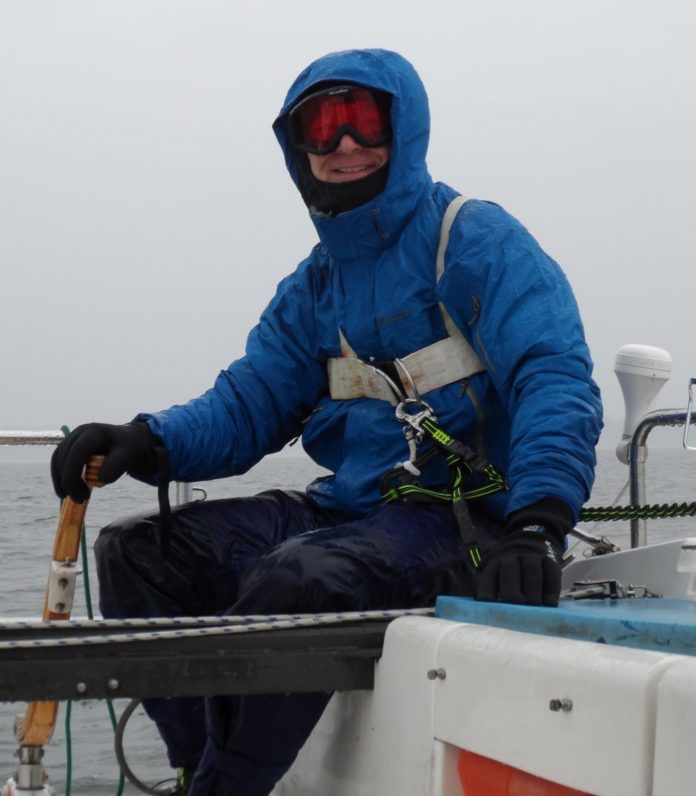The first real winter blast of the year poked south of the 25th parallel this week, as sun-seeking sailors as far south as the Keys poked their head out the companionway and decided, “I’d better put on another layer.”
Whether you want to cruise the higher latitudes or extend your sailing season this winter, the right clothing is important. Over the years, Practical Sailor has published a number of tests and reports on the clothing that keep us warm when the wind chill dips toward freezing.
A keyword search of the relevant categories on the PS website —gloves, socks, boots, foul weather gear, base layers, caps, wet suits, dry suits, survival suits, etc. — will yield the results from specific tests. But before you dig into the individual topics, I’d recommend that you first read a report from technical editor Drew Frye that takes a broader look at keeping warm. Frye, who keeps his boat sailing all winter on the Chesapeake, has had many cold days to explore the topic in his report, “Sailing Clothes for Cold Weather.”
The antidote to the wintry fashion of a clothing catalogue, Frye’s research in the area could be summed up in the phrase: “It’s not a fashion show out there.” By sifting through fields ranging from gardening, to commercial fishing, to ice-climbing, and incorporating the wisdom from other PS contributors in the field, he guides the frugal winter sailor through the fundamentals of keeping warm in wet and cold weather without spending a fortune.
The get the full picture, complete with links to prior PS tests in the various categories, you’ll want to read the full article. For now, here are a few key takeaways.
Because the climate challenges vary by location, your own choice boils down to budget, needs, and personal preference.
Layers. Start at the bottom (layer). Test the underlayers and accessories first. How they fit your body alone and under your foul weather gear is important. If you start shopping for an outer layers before establishing a good base layer, you may be overcompensating—and overspending—to stay warm. Test by sailing deeper into the fall, using whatever outer layers you already have.
No leaks. Remember that air leaks matter. If your feet are cold, the problem may be your hat or your legs where air is getting in. Only after you’ve figured out what it takes to stay warm all day, through a variety of activities, are you ready to look at the more expensive outer layers designed to keep you you dry.
Drysuits. Consider a drysuit as an alternative to foul weather gear in cold conditions. Although drysuits are less breathable, they make agile deckwear in tough conditions, with unbeatable waterproof protection and warmth. They offer superior hypothermia protection in case of immersion, making them vital for kayaking, dinghy rides in rough water, and for in-water access to inspect the hull and untangle fishing gear.
In very cold water, you need either a drysuit or immersion suit for each person, and a drysuit offers an opportunity to save duplication. Pair this with lighter coastal-weight foul weather gear for less demanding conditions.
Special considerations. The boat type (is your helm protected?) and expected conditions will likely determine how much you spend. A full kit, top-to-bottom for extreme conditions can cost more than a thousand dollars, but for most sailors, smart layering you can keep you warm and dry for a fraction of that.
In milder conditions, lighter coastal racing gear is suitable outerwear for more limited exposure (good wrist and neck seals are still important). A drysuit can be reserved for kayaking, dinghy rides in freezing water, and of course, the most horrible days underway.
High latitudes. If you’re headed for higher latitudes, comfort is critical, because the best gear is useless if you don’t wear it. While on watch on long passages, you’ll want to be fully dressed or nearly so, ready in case an emergency requires your attention on deck. In heavy weather, the off-watch crew might also need to be dressed and ready. We’ve spent many long nights sleeping during the off-watch in bibs, or even full foul weather gear.
If you often extend your sailing season late into fall, or even through the winter, we’d love to hear what clothing, tips, or techniques help you stay warm. You can share them in the comments below or email [email protected].








































thank you for all the good advices, reading them for years and many of them are useful to teach to our younger sailors and helping me to remember what I learned two generation ago. still learning, though … keep the good work going 🙂 by the way I have your book – happy sailing, klaus
A dry suit is an excellent choice for all the reasons stated except under water boat inspection-too much flotation. I’ve experimented and even with 25 lbs. of lead I still had excessive buoyancy. The plus is that in a pinch you really don’t need a PFD topside when wearing one! For below water work I’m back to a wet suit.
You can get rid of the excess bouyancy by fitting a dump valve into a sleeve on your dry suit. Although you still need a small amount of added weight, you will also need a diving BCD to ensure you can maintain depth.
That’s really nice post. I appreciate your skills, Thanks for sharing.
I’ve found military surplus to be a good source of warm clothing. I have a jacket that is rubber lined and then has a quilted layer inside. Also lined bib overalls. My favorite is a pair of arctic mittens. Room inside for gloves.
Nice to know how to wear correct clothes for this occasion.